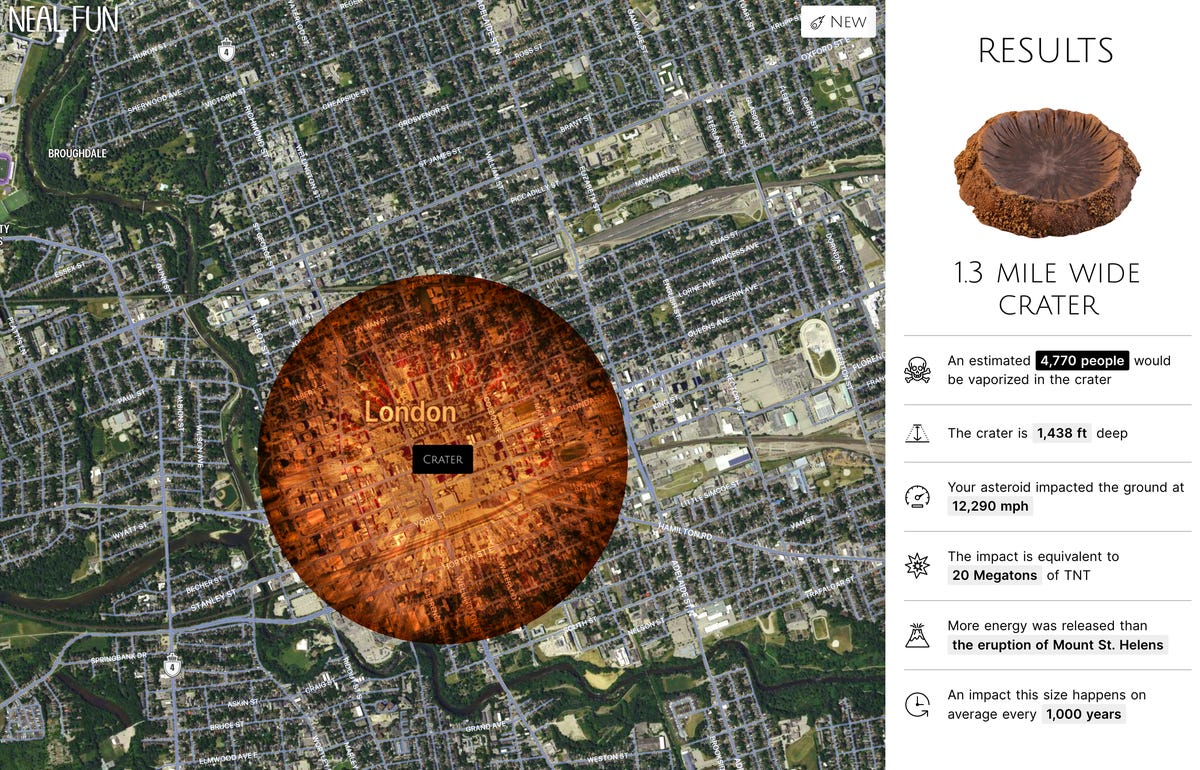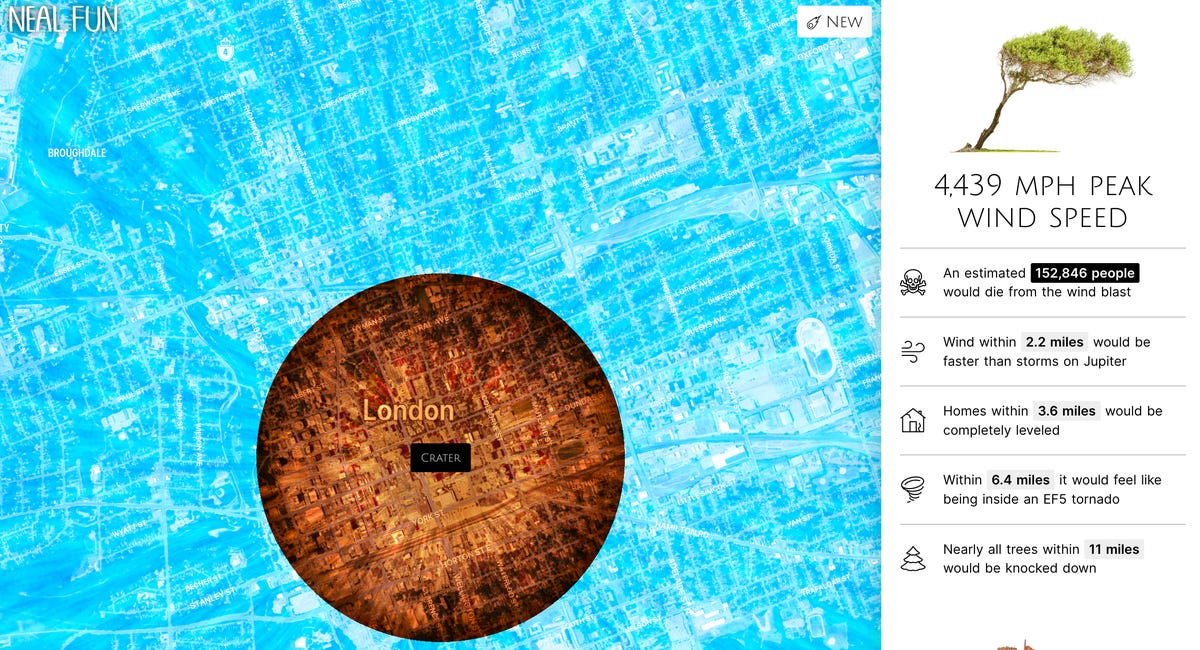If an asteroid made of pure gold, with a diameter of 2,600 feet and blasting at 77,000 miles per hour, came in at an angle of 48 degrees and hit New York City’s Upper East Side, aka around where I live, I unfortunately now know what would happen.
Myself and 6,363,353 people would be vaporized within the space rock’s resulting crater, a massive chasm over half a mile deep. The shard would release more energy than the last volcanic eruption of Yellowstone, a colossal disaster that, thousands of years ago, spewed ash, magma and debris far enough to cover most of the continental United States.
Or at least that’s what I learned from an asteroid simulation website this afternoon while sipping on a cup of coffee.
The Asteroid Launcher is a free, data-driven concept created by Neal Agarwal, a developer widely known by his online persona: neal.fun. Agarwal’s goal is basically to blend immense arrays of data and interesting mental dilemmas to form clever, interactive online thought experiments, like this one that tells you what kind of devastation would follow an asteroid smashing into your town.
“The main inspiration,” Agarwal told me over email, “was definitely growing up watching movies like Deep Impact and Armageddon! I’ve always wanted to have an online tool that would let me test out different impact scenarios and see the effects.”
But of course, the key here with Asteroid Launcher lies in Agarwal’s pseudonym.
There are thankfully no known significant impact threats for the next hundred years or more, according to NASA — and, worst case, the agency is well on its way toward generating a sort of asteroid defense system with the resounding success of its DART mission, which took place earlier this year.
Still, it doesn’t hurt to cater to our intrusive thoughts once in a while. Just for fun.
Peruse Agarwal’s projects and you’ll find an awesome array of rabbit holes to get lost in.
The Size of Space progressively presents you with larger and larger objects, starting with an astronaut and making its way through stars so enormous they make our sun look like a feeble yellow pom-pom. Spend Bill Gates’ Money offers you $100 billion to spend on items ranging from a 12 pack of Coca-Cola all the way to a literal Boeing 747 commercial airplane. It shows you how much money multibillionaires are working with day to day.
And my personal favorite, Absurd Trolley Problems takes you on an illustrative, ethical journey based on English philosopher Philippa Foot’s fictional scenario where an onlooker has the choice to save five people in danger of being hit by a trolley — except the only way to save them is by killing one person in their stead. The hard part about this isn’t so much the decisions, but the fact that you should, hypothetically, remain consistent in every one of those decisions.
“I’ve kept a big ideas list since I was 16, and have recently passed 1,000 project ideas written down (most of them terrible),” Agarwal said. “The ideas can come from everywhere, from books and movies to a conversation with a friend. I think the important thing is writing them down and being as open as possible to new and weird ideas. Sometimes two to three bad ideas can combine and form a great project.”
Which brings us to Agarwal’s latest endeavor: Asteroid Launcher.
You begin by designing your own asteroid, entering a material, rock diameter, speed and impact angle. Then, you can select any location on a realistic map to the left of the screen. All that remains, at that point, is to click a giant button that says LAUNCH ASTEROID.
Boom.
You arrive at a page that tells you, theoretically, what you’ve just done to your location of choice.
These results are surprisingly detailed, as Agarwal embedded his code with asteroid information gleaned from academic science publications, such as a doctoral thesis about asteroid impact risk and a peer-reviewed population vulnerability model authored by experts from NASA, Lancaster University and the University of Southampton.
However, it does appear that some question the results of Asteroid Launcher — one scientist, for instance, tweeted his preference for the more old-school Earth Impact Effects Program to satisfy doomsday cravings.
Though, to that end, Agarwal says the Earth Impact Effects Program uses the same equations as Asteroid Launcher because both are based on a research paper written by Gareth Collins, an asteroid impact expert at Imperial College London. “They’ll give pretty much the same results,” he explained, noting that Clemens Rumpf, an asteroid risk expert who formerly worked at NASA, also contributed to his project.
“The goal of neal.fun is to bring back the weird and fun internet!” Agarwal said. “I grew up at a time when the internet was full of strange and fun flash games and experiments, and watched that all slowly go away as social media took over. Now the web is finally becoming powerful enough again to create fun digital experiences, and I’m excited to keep exploring the potential with new projects.”
On Asteroid Launcher, once you’ve pressed the big red button, scroll down a little, and you’ll catch far more than fatalities spurred by your asteroid design.
Agarwal tells you how many gigatons of TNT your explosion equaled, how many people would receive second-degree burns if your asteroid was closer to a huge fireball, the radius within which peoples’ eardrums would rupture from the shock wave and within which homes would be completely leveled from wind speeds upon impact.
It’s darkly obsessive to check out as many asteroid designs as you can. Immediately after making my dream gold impactor, I plugged in the stats of the asteroid that NASA’s DART spacecraft punched into in an attempt to change the relatively small space rock’s orbit around a larger hunk of space rock.
I couldn’t get things to be completely accurate, because this is so theoretical, but here’s what I came up with.
Dimorphos is considered to be made of “rubble,” aka a bunch of materials, so for material, I went with generic stone. It’s actually about 525 feet in diameter, but Asteroid Launcher requires some rounding. I put in 500 feet. As for speed at time of impact, a parameter we don’t know, I popped in the speed at which the DART spacecraft hit the rock, because, well, why not? That came out to something like 14,400 miles per hour, which had to be rounded as well. I set the location to London and angle to 90 degrees for no reason whatsoever.
Here’s what we got for results — they’re much less shocking than my first ridiculous, gleaming monster asteroid.
My next plan was to input the parameters of the dinosaur-killer asteroid, Chicxulub. But get this: It was so gigantic it didn’t even fit in the diameter section.
“Asteroid impact science is still an evolving field and not everything is known yet,” Agarwal said. “Generally the larger the asteroid, the more uncertain we are about the effects.”




